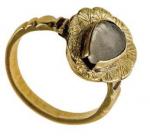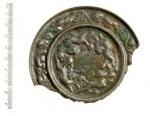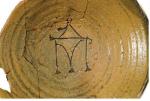Summary (English)
KASTRITSI FORTRESS (Valentin Pletnyov, Maria Manolova-Voikova – mara_manolova@yahoo.de, Igor Lazarenko) Kastritsi was protected by a fortification wall, 200 m long, preserved up to 3 m in height, built of ashlars bonded with mortar and with repairs, with five circular, one rectangular and one triangular tower. There was a citadel in the eastern end of the fortress. The fortification gate was 3 m wide, with a corridor 3.40 m long situated in the middle of the fortification wall. There was a donjon corner tower with a chapel on its ground floor situated in the northwestern end of the fortress. A postern, 2.25 m wide, was discovered in the western part of the fortification wall. During the 14th century the postern was closed: coins of the Bulgarian King Ivan Alexander (1331 – 1371) were found in a joint between the stones. During the 13th – 14th centuries, buildings were constructed adjacent to the inner side of the fortification wall. A square with five streets leading towards it was documented. A Late Antique building with two rooms was discovered in trenches ХХІІІ 14–24. The explorations of the street flanked by parallel buildings arranged in a line continued in trenches ХХІV 3–5, 2–12. Pottery of the 13th – 14th centuries and coins of the second half of the 14th century were found in the buildings. The building in trench ХVІІ 21 was thoroughly explored and coins of the end of the 6th century AD and fragmentary amphorae were found. The building was partly destroyed by the Mediaeval buildings. A street paved with stone slabs was discovered and folles of Heraclius minted in AD 614 were found in the joints between the slabs. A house with two rooms was discovered and a hoard, containing 166 silver grossi of the Bulgarian King Ivan Alexander with his son Michael, was found close to the oven, placed in a small jug with sgraffito decoration. The finds from the excavations included pottery, including dishes with sgraffito decorations and monograms that read: Demetrius, a gold finger-ring, a decorated bronze mirror, copper lamps and dishes, a bronze cense, belt appliqués and buckles, weights for fishing nets and fishing rods, exagia, arrowheads for bows and cross-bows, 473 coins: Odessos (4th – 2nd centuries BC), a Roman Republican denarius (1st century BC), Licinius II, Constantine the Great, Constantius II, Julian, Theodosius I, Valentinian II, Arcadius, Marcian, Anastasius I Dicorus, Justin I, Justinian I, Justin II, Tiberius II Constantine, Maurice, Phocas, Heraclius (minted up to AD 614), anonymous Byzantine folles (classes A2 and B), Constantine X Ducas, Michael VII Ducas, Manuel I Komnenos, Michael VIII Palaiologos, Andronikos II Palaiologos, Michael IX Palaiologos, Andronikos III Palaiologos, the Bulgarian Kings Theodor Svetoslav (1300 – 1321/1322), Michael III Shishman (1323 – 1330), Ivan Alexander and Ivan Shishman (1371 – 1395), the Despot of Dobrudzha (Northeastern Bulgaria) Dobrotitsa (1366 – 1385), a tornesello of the Despot of Epirus John II Orsini (1323 – 1335), the Golden Horde, mangir and akçe of the Ottoman Sultans Murad I and Bayazid I, and Emir Syuleiman (minted up to 1404).
- Valentin Pletnyov - Regional Museum of History – Varna
- Maria Manolova-Voikova - Regional Museum of History – Varna
- Igor Lazarenko - Regional Museum of History – Varna
Director
Team
Research Body
- Regional Museum of History - Varna






![Download [PDF]](/excavation/skins/fasti/images/results/download_sml.png)


